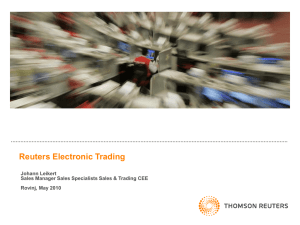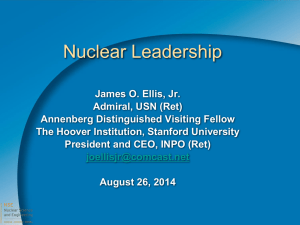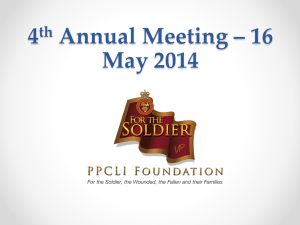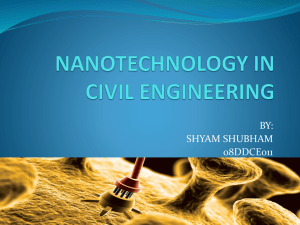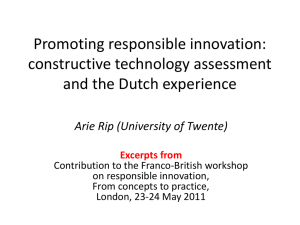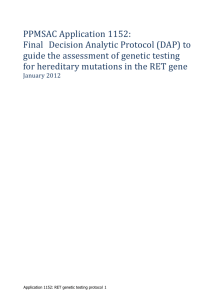Research Experience for Teachers
advertisement
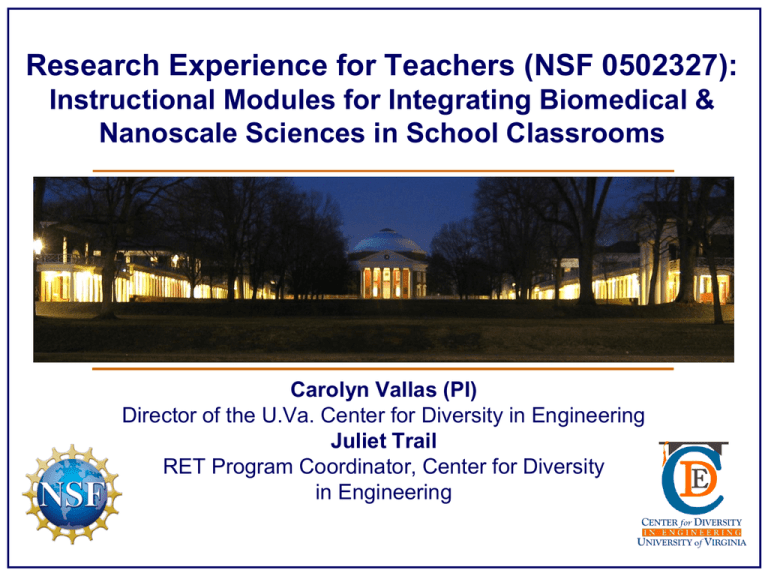
Research Experience for Teachers (NSF 0502327): Instructional Modules for Integrating Biomedical & Nanoscale Sciences in School Classrooms Carolyn Vallas (PI) Director of the U.Va. Center for Diversity in Engineering Juliet Trail RET Program Coordinator, Center for Diversity in Engineering RET Program Rationale • NSF’s RET programs encourage active participation of K-12 teachers in science, technology, engineering, and mathematics (STEM) research, to enable them to teach STEM concepts to their students and to encourage students to pursue careers in engineering and computer science • Supports national efforts to develop a skilled 21st-century American workforce, specifically in the STEM fields • Change the Equation 2010 address by President Obama: “Leadership tomorrow depends on how we educate our students today–especially in science, technology, engineering and math.....[Our success] depends on us restoring an insistence on excellence in our classrooms and from our children.” • National Science Board Report 2009 report, Essential Components of an Effective STEM Education System, include 1. Need for high-quality teachers 2. Need to provide teachers with world-class resources and assistance 3. Enable early student exposure to STEM concepts in pre-kindergarten and elementary school RET Program Description • U.Va. Site Focus: “Instructional kits and modules for integrating biomedical and nanoscale sciences in school classrooms.” • Summer 2010 Program: 15 Teachers, 5 Weeks • 3 elementary, 5 middle, 7 high school; 14 in-state, 1 out-of-state • Conducted independent research investigations in Biomedical, Civil/Environmental, Electrical/Computer, Materials Science, Mechanical, & Systems Engineering as well as Physics • Annual Teacher’s Workshop – INNOVATION: Teaching Nanotechnology within Virginia SOLs RET Summer Program Description • Host Laboratory: Faculty Mentor, Graduate Students • Support: Weekly Stipend, Housing, Meal Stipend • Learn about Research Projects of Host Lab • Conduct Independent Investigations & Experiments • Weekly Program Meetings, Special Presentations • Societal & Ethical Dimensions of Nanotechnology Course • Weekend Excursions (Tour of Monticello, James River Tubing) RET Summer Program Outcomes • Teachers create novel teaching kit based on summer research • Correlate kit & lesson plan(s) to all related SOLs • Present kit and research poster at RET Final Colloquium • Submit short Research Paper outlining RET research & kit • RET2 – return for second summer • Broader Impacts: Present to home districts, state & national meetings • Articles In Press: American Society for Engineering Education & Virginia Journal of Science Education (VJSE) RET Summer Program Assessment • Assessment for 2010 program via 2 surveys 1. Program Survey on final day of program (100% response) 2. Classroom Extension Survey to be distributed May 2011 • Gather feedback on RET teaching kits • Track presentations or articles beyond individual classrooms • Investigate ways to assess student learning outcomes • Was the target population reached? • Target: Recruit teachers from schools serving high proportions of those under-represented in STEM, including African American, Hispanic, Native American, and Free/Reduced Lunch populations • 53% of 2010 participants are in schools with high minority populations (African American, Hispanic, &/or N. American) • 40% of school districts served by RET teachers exceed the VA free/reduced lunch average of 38% (at 49-59%) RET Summer Program Assessment • Summer Program Survey Responses Positive* I would recommend this program to colleagues. I am interested in conducting scientific research again in the future. I was able to develop a novel teaching kit/module/demo/lesson based on my research experience. I feel comfortable presenting my novel RET teaching materials in the classroom next year. I had sufficient contact with the RET program staff. I would recommend my faculty mentor to other RET participants. 100% 100% 100% 100% 100% 87% *Strongly Agree/Agree • “This experience was exactly what I wanted. It will translate directly into my teaching.” • “I loved the RET experience. I gained many opportunities that would otherwise be unavailable to me in my home county. I will share my experience with my colleagues, friends, and family. I was prepared for the amount of work that was requested of me in the program. Thank you for such a great experience!” Innovative Module for Elementary School: Carrie Lewis, Robotic Twiddlefish Module • Research Project: Modeling Skeletal Architecture of Batoid Fins and their Motions • Faculty Mentor: Dr. Sylvia Blemker, M3 Lab • Department of Mechanical and Aerospace Engineering • Dearing Elementary, Lynchburg • 98% African American, 59% Free/Reduced Lunch • Teaching Module: • Students pursue testable questions about force, motion and the relationships of form to function. • They will collect data to prove or disprove their ideas and present their findings using charts, graphs, and workable models. Classroom Extension • Science SOLs in Module • • • • • • • 2.1, 3.1, 4.1, 5.1 Scientific investigation 3.2, 3.3 Simple machines & characteristics 3.4 Physical adaptations 5.4 Compounds, solvents, solutes, solutions 5.6 Ocean environments 4.2 Structural adaptations 4.5 Characteristics of moving objects • Math SOLs in Module • • • • 2.15, 4.11 Symmetry 2.17, 2.19, 3.17 Graphing 3.9, 5.8 Measurement 5.16 Data analysis • Reading SOLs for Grades 25 also correlated to module • Broader Impacts include state presentations at VAST & Children’s Engineering Conferences; article in press-VJSE; national poster presentation at NSTA * All photo permissions obtained Innovative Module for Grades 6-12: Randy Applegate, Nanotechnology Kit • Research Project: Computational Modeling of Atomic Mixing and Defects with Laser Interactions • Faculty Mentor: Leonid V. Zhigilei, Computational Materials Lab • Department of Materials Sciences &Engineering • Gloucester High School, Gloucester County • 20% African Amer., 5% Hisp., 3% N. Amer., 33% Free/Reduced Lunch • Teaching Kit: 4 Nanotechnology Lessons (Cost <$70) Ag film Cu substrate Classroom Extension Module 1: Nanotechnology–An Introduction Module 2: Atomic Modeling–Metallic Crystal Structure (top) Module 3: Atomic Level–Metallic Crystal Structure Defects (middle) Module 4: Atomic Modeling–Observing Molecular Behavior (bottom) Mod.4. Students utilize JAVA Applet designed by the UVA Computational Material Lab Correlations to 78 SOLs for Grades 6-12 (handout available) Broader Impacts: • • • • Presented kit to Gloucester Cty School Board VAST conference presentation RET Article in press for VJSE Taught kit at the Feb. 2011 INNOVATION: Teaching Nanotechnology Workshop, sponsored by the CDE RET program Innovative Module for High School: Ritu Linhart, Nanofibers for Tissue Engineering • RET1 Summer 2009 & RET2 Summer 2010 • Research: Boron Based Biomaterials for Tissue Engineering • Faculty Mentors: Ed Botchwey (Biomedical Engineering) & Cassandra Fraser (Chemistry) • Graduate Student Mentor: Richard Murray • Coral Glades High School, Coral Spring, FL • 21% Af. Amer., 21% Hisp., 3% Asian/Pac. Islander, 3% Multiracial, 2% Native Amer., 49% White, 27% Free/Reduced Lunch • RET1: Created Teaching Extensions for 9-12 Physics • RET 2: Created Teaching Extensions for 9-12 Chemistry Nanofibers in Tissue Engineering: Electrospinning Experimental Results • Successfully electrospun 85:15 Optical Nanofiber Properties PLAGA nanofibers blended with BF2dbm(I)OH dye • Fiber-dye blend retained morphology in simulated physiological parameters. • Ratiometric analysis assessed relative O2 levels in different cell environments • Outline of future for project: A • In vitro: (1) Determine cytocompatibility of dye-nanofiber scaffolds, (2) Track B (Left) Emission in room air (A) and hypoxia (B). Fluorescence (blue) captured 440-480 nm; Phosphorescence (green) captured 515-545 nm. Ratiometric Imaging A B O2-dependent metabolic processes • In vivo: (1) Determine toxicity of dyenanofiber polymer blends, (2) Track O2-dependent metabolic processes in mice subjects (Above) Nanofiber scaffolds blended with BF2dbm(I)OH dye. Ratio of fluorescence (440480 nm): phosphorescence (515-545 nm) Shown: room air (A) and hypoxia (B). Classroom Extension • Students experiment with spinning fibers from readily- available polymers: • Gelatin, collagen, corn starch, & chitosan • Experiment with non-toxic, non-acidic solvents • Teacher instruction includes: • Ionic vs. covalent compounds, inorganic vs. organic in context of biocompatibility for use in tissue engineering • Broader Impacts: • RET1 Poster at NSTA Conference • Taught module: 2010 INNOVATION Workshop (UVA) • Received Teacher Quality Grant, Florida Dept. of Ed.: developed RET-based module for statewide use • VAST Conference: presented RET2 module • Science 9-12 Standards for Nanofiber Module: P.8.6 P.8.12 P.10.9 P.10.13 P.10.16 N.4.1 N.4.2 Chemical bonding forces Carbon atom properties and possible carbon compounds Energy quantization Relate configuration of static charges to electric field and forces Relationship between moving charges & magnetic fields and technologies applications Scientific knowledge and reasoning to inform society's decision making Assessment/cost benefit analysis of strategies for solving a specific societal problem RET INNOVATION Teacher’s Workshop • Workshop Mission: To enhance science and math instruction in the Commonwealth of Virginia through the incorporation of nanotechnology and nanoscience concepts into K-12 classroom instruction. • Format: 1.5 days, hands-on activities, lectures, readings, classroom resources provided, External and UVA faculty presenters • 2010 Workshop: 29 Applied, 29 Accepted • Represented 26 schools from 15 VA districts, 1 university, 1 from VA DOE • 2011 Workshop: 77 Applied, 66 Accepted • Represented 47 different schools from 25 VA districts, multiple curriculum designers and design-teams attended Conclusions & Next Steps • INNOVATION Workshop Survey Responses 2010 2011 N=29 (100%) N=61 (95%) 100% 95% (5%) 93% (7%) 69% (15%) After completing this workshop, I can now relate this new nanotechnology teaching to the required Virginia Standards of Learning curriculum. 90% (10%) 75% (15%) Overall, this workshop met my expectations. 96% (4%) 77% (20%) After completing this workshop, I can now define nanotechnology and understand related terms and concepts. After completing this workshop, I can now plan a new lesson, lab, or demo designed to teach new nanotechnology concepts. Are you interested in participating in the UVA Research Experience for 36% Yes 61% Yes Teachers (RET) Program? *Strongly Agree/Agree (Somewhat Agree) • Currently applying for new RET Program Grant (NSF) • • • • • Continue summer research program Continue to include elementary, middle, and high school teachers Add participation of community college instructors for summer research Continue K-12 nanotechnology workshop Further develop methods to assess student learning outcomes


